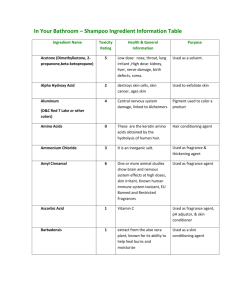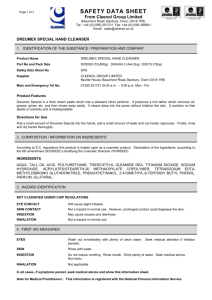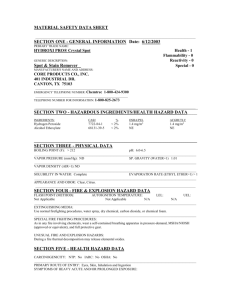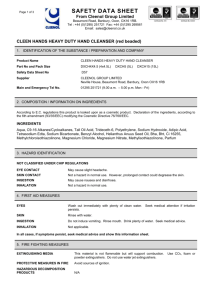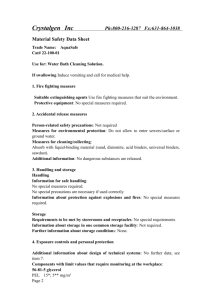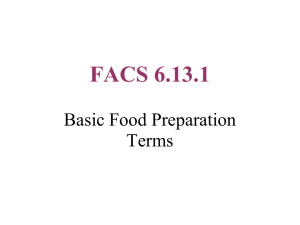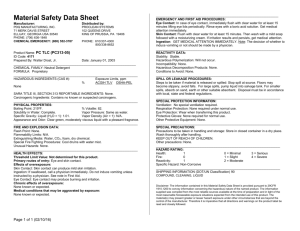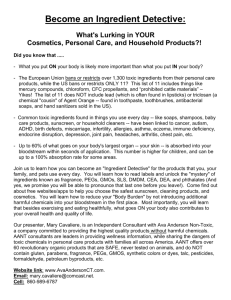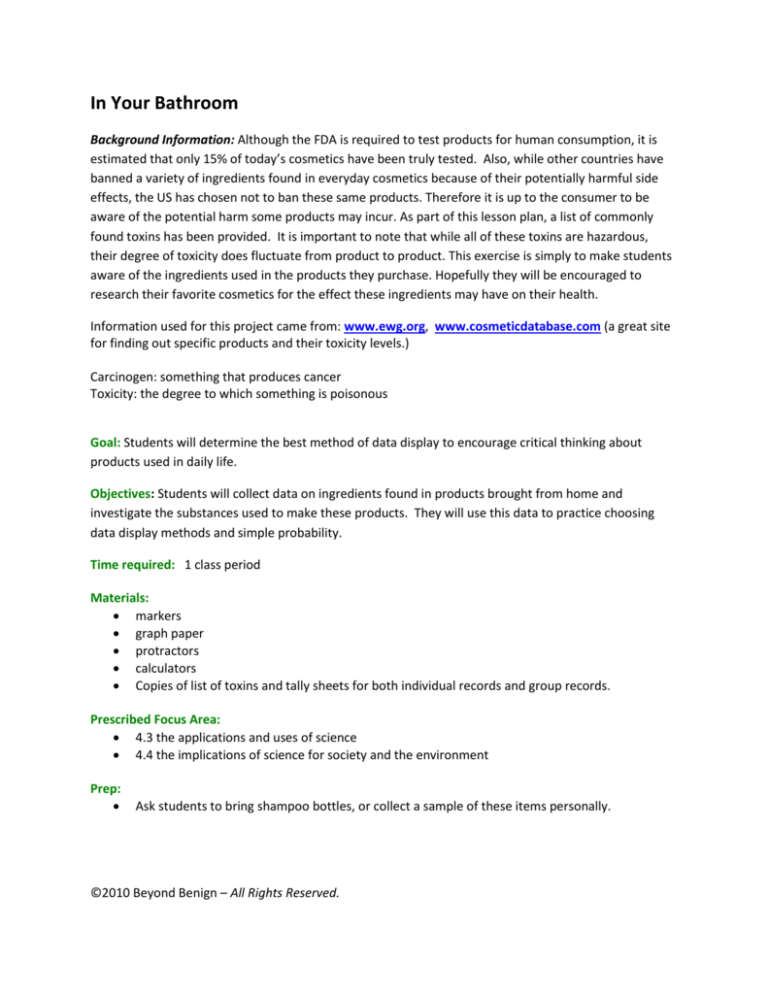
In Your Bathroom
Background Information: Although the FDA is required to test products for human consumption, it is
estimated that only 15% of today’s cosmetics have been truly tested. Also, while other countries have
banned a variety of ingredients found in everyday cosmetics because of their potentially harmful side
effects, the US has chosen not to ban these same products. Therefore it is up to the consumer to be
aware of the potential harm some products may incur. As part of this lesson plan, a list of commonly
found toxins has been provided. It is important to note that while all of these toxins are hazardous,
their degree of toxicity does fluctuate from product to product. This exercise is simply to make students
aware of the ingredients used in the products they purchase. Hopefully they will be encouraged to
research their favorite cosmetics for the effect these ingredients may have on their health.
Information used for this project came from: www.ewg.org, www.cosmeticdatabase.com (a great site
for finding out specific products and their toxicity levels.)
Carcinogen: something that produces cancer
Toxicity: the degree to which something is poisonous
Goal: Students will determine the best method of data display to encourage critical thinking about
products used in daily life.
Objectives: Students will collect data on ingredients found in products brought from home and
investigate the substances used to make these products. They will use this data to practice choosing
data display methods and simple probability.
Time required: 1 class period
Materials:
markers
graph paper
protractors
calculators
Copies of list of toxins and tally sheets for both individual records and group records.
Prescribed Focus Area:
4.3 the applications and uses of science
4.4 the implications of science for society and the environment
Prep:
Ask students to bring shampoo bottles, or collect a sample of these items personally.
©2010 Beyond Benign – All Rights Reserved.
Procedure:
Hand out containers or have the students look at the containers they brought with them.
Hand out the student sheet and the shampoo ingredient information table.
Have the students review the information about ingredients.
Have the students answer questions 1 & 2 on the student sheet.
After everyone has a tally for their own ingredients and has answered through questions two,
have the class submit all of their data and compile a tally sheet on the board of the data from
the entire class. Use the categories of:
o High hazard
o Medium hazard
o Low hazard
Give students the Graph Information sheet. Review expectations.
Data from each of these lists can be used to practice measures of central tendency and form any
of a number of graphic displays: Stem/leaf, bar graph, histogram, and pie chart. Your choice will
depend on the kind of data you collect (For instance a stem/leaf does not work well if the data is
all single digits. A histogram does not work well unless there are meaningful intervals of data.)
Discuss with your students the fact the appropriateness of different forms of display. Let them
decide which form (bar graph, circle graph, etc.) would best relate the findings from this data.
Optional: spend a day in the computer lab, allowing students to research the ingredients that
weren’t included in the chart
Extensions:
Probability: You can make up probability problems like the following:
o a. If these were the shampoo choices on the store shelf, and I chose randomly from
them, what is the probability that I would have chosen a shampoo that has two or more
highly hazardous ingredients?
o b. What would be the probability that I would choose a shampoo with 2 highly
hazardous ingredients and with 1 or more ingredients of medium hazard?
o c. What is the probability that I would get a product that contains Acetate?
Again, these questions would be modified according to your data and the interests of your
students.
Other interesting things to note:
1. Ask the students how many of their products that have toxins in them also have the word
“Healthy”,” “Gentle” “Natural” in the name.
2. Are there any brands that showed up more often for having toxins?
3. Are any students going to change brands or do more research on their brands as a result of
these findings?
©2010 Beyond Benign – All Rights Reserved.
In Your Bathroom - Student Sheet
1.
Make a tally of how many high hazard, medium hazard, and low hazard ingredients were in
your product.
2.
Based on your shampoo ingredients:
a. What is the percentage of high hazard ingredients? ________
b. What is the percentage of medium hazard ingredients? ________
c. What is the percentage of low hazard ingredients? ________
3.
Based on classroom data:
a. What is the percentage of high hazard ingredients? ________
b. What is the percentage of medium hazard ingredients? ________
c. What is the percentage of low hazard ingredients? ________
4.
Questions for thought:
a. Do you think the products from your class are a good representation of the products on
the market? If not, why not?
b. Is there any product that you are currently using that you will no longer use or would
like to research further?
©2010 Beyond Benign – All Rights Reserved.
In Your Bathroom – Shampoo Ingredient Information Table
Ingredient Name
Toxicity
Rating
Health & General
Information
Acetone (Dimethylketone, 2propanone,beta-ketopropane)
5
Low dose: nose, throat, lung
irritant ,High dose: kidney,
liver, nerve damage, birth
defects, coma.
Used as a solvent.
Alpha Hydroxy Acid
2
destroys skin cells, skin
cancer, ages skin
Used to exfoliate skin
Aluminium
4
Central nervous system
damage, linked to Alzheimers
Pigment used to color a
product
Amino Acids
0
These are the keratin amino
acids obtained by the
hydrolysis of human hair.
Hair conditioning agent
Ammonium Chloride
3
It is an inorganic salt.
Used as fragrance &
thickening agent
Amyl Cinnamal
6
One or more animal studies
show brain and nervous
system effects at high doses,
skin irritant, Known human
immune system toxicant, EU
Banned and Restricted
Fragrances
Used as fragrance agent
Ascorbic Acid
1
Vitamin C
Used as fragrance agent,
pH adjustor, & skin
conditioner
Barbadensis
1
extract from the aloe vera
plant, known for its ability to
help heal burns and
moisturize
Used as a skin
conditioning agent
(D&C Red 7 Lake or other
colors)
©2010 Beyond Benign – All Rights Reserved.
Purpose
Benzene (Benzoic, Benzyl, any
compound that contains these
words)
6
Inhalation affects nervous
system, carcinogenic, birth
defects
Used as a solvent,
fragrance agent,
preservative, & thickening
agent
BHA – BHT
10
carcinogenic ( banned in
other countries)
Antioxidant & fragrance
agent
Biotin
2
animal studies show brain
and nervous & reproductive
system effects at low doses
Used as a hair conditioner
Butylene glycol
1
Irritation (eyes, skin, or lungs)
Used as skin conditioner
& solvent
Butyphenyl methylpropional
8
Known human immune
system toxicant, evidence of
human neurotoxicity
Used as a fragrance &
perfuming agent
Cetyl alcohol
1
Derived from whales or
dolphins or Vegetable cetyl
alcohol, like coconut
Used as an emulsifier and
surfactant
Citric Acid
2
Can irritate skin
Used to balance pH
Cocamide MEA
2
Not safe for use in products
intended to be aerosolized
Used as emulsifier &
thickening agent
Cocamidopropyl betaine
5
Skin Sensitizer - An agent that
can induce an allergic
reaction in the skin or lungs
Used as anti-static, hair
conditioner, & surfactant
DEA, TEA, MEA
7
highly carcinogenic
Used to balance pH
DMDM Hydantoin
8
Can instigate itching, burning,
scaling, hives, and blistering
of skin; Irritation (eyes, skin,
or lungs)
Used as a preservative
FD&C colors (D&C, coal tar)
4
carcinogen
Pigment used for color
©2010 Beyond Benign – All Rights Reserved.
Glycol (propylene glycol)
4
causes skin irritation and
sensitization as low as 2%
concentration, cosmetics can
contain up to 50% of the
substance.
Used as humectants, skin
conditioner, & solvent
Glycerin (GLYCERYL
MONOSTEARATE)
1
monoester of glycerin and
stearic acid.
Used as surfactant,
emulsifier, & skin
conditioning agent
Keratin
2
Use is restricted in Canadian
cosmetics based on
concentrations
Used as hair conditioning
agent, humectant
Limonene
6
Known human immune
system toxicant, EU Banned
and Restricted Fragrances
Used as a perfume
Niacinamide
2
One or more animal studies
show liver effects at very low
doses, possible carcinogen
Used as hair conditioner
& smoothing agent
Panthenol
2
One or more animal studies
show broad systemic effects
at high doses
Used as an anti-static &
skin conditioner
Paraben
(Butylparaben,Isobutylparabe
n, Sodium)
6
carcinogen
Used as preservative
PEG (may be followed by a
number)
10
carcinogen
Used as surfactant &
emulsifier
Phthalate (also look for
Diethyl or Dibutyl)
10
cancer causing, fertility,
banned in Europe
Used as a solvent
PolyQuaternium (10, 11, 22,
24, 28,39, 51
0
Safe as used in cosmetics
according to industry panel
(Cosmetic Ingredient Review,
CIR)
Used as anti-static agent
& hair fixative
©2010 Beyond Benign – All Rights Reserved.
Polysorbate-20
1
One or more animal studies
show gastrointestinal effects
at high doses
Used as surfactant &
emulsifier
Sodium lauryl sulfate ( SLS,
SLES, formaldehyde,formalin,
MDM, hydantoins,
surfactants)
4
skin irritant & alleged
carcinogen
Used as a surfactant
Quaternium-15
6
Known human immune
system toxicant & skin irritant
Used as anti-static agent
& preservative
Quaternium (18, 22, 37)
0
Anti-static agent
Tetrasodium EDTA
2
Risk of serious damage to
eyes
alters skin structure,
allows other chemicals to
penetrate deeper into the
skin
Tocopherol Acetate
4
Skin toxicant
Skin conditioner
Tocopherols and tocotrienols
1
Vitamin E
Used as anti-oxidant,
fragrance agent, & skin
conditioner
Toluene
10
bone marrow, liver, kidney
damage, birth defects, brain
cancer
Used as anti-oxidant and
solvent
Triethanolamine
6
carcinogen
Used to adjust pH, as a
surfactant and emulsifier
Information taken from Skin Deep at http://www.cosmeticdatabase.com/
©2010 Beyond Benign – All Rights Reserved.
©2010 Beyond Benign – All Rights Reserved.
In Your Bathroom – Graph Information
Design a data display that you think best illustrates the findings your class has tabulated concerning
toxins in shampoo. Follow the steps below to decide what information you want to highlight and what
data display would best illustrate your information.
1. What information did you find most interesting or you felt affects you the most?
2. As data can be interpreted differently, what is the message you want your display to convey:
toxins are rampant and the buyer has to be careful, or we don’t really need to worry about the
number of toxins found in shampoo.
3.
-
Given decisions made above choose from one of the choices below: Your choices are
box and whisker
histogram
pie chart
bar graph
stem and leaf
line graph
©2010 Beyond Benign – All Rights Reserved.

